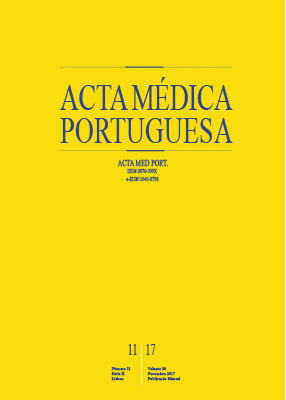Cross-Cultural and Psychometric Properties Assessment of the Exercise Self-Efficacy Scale in Individuals with Spinal Cord Injury
DOI:
https://doi.org/10.20344/amp.8884Keywords:
Motor Activity, Self Efficacy, Spinal Cord Injuries/rehabilitation, Validation StudiesAbstract
Introduction: The Exercise Self-Efficacy scale (ESES) is a reliable measure, in the English language, of exercise self-efficacy in individuals with spinal cord injury. The aim of this study was to culturally adjust and validate the Exercise Self-Efficacy scale in the Portuguese language.
Material and Methods: The Exercise Self-Efficacy scale was applied to 76 subjects, with three-month intervals (three applications in total). The reliability was appraised using the intra-class correlation coefficient and Bland-Altman methods, and the internal consistency was evaluated using Cronbach´s alpha. The Exercise Self-Efficacy scale was correlated with the domains of the Quality of life Questionnaire SF-36 and Functional Independence Measure and tested using the Spearman rho coefficient.
Results: The Exercise Self-Efficacy scale-Brazil presented good internal consistency (alpha 1 = 0.856; alpha 2 = 0.855; alpha 3 = 0.822) and high reliability in the test-retest (intra-class correlation coefficient = 0.97). There was a strong correlation between the Exercise Self-Efficacy scale-Brazil and the SF-36 only in the functional capacity domain (rho = 0.708). There were no changes in Exercise Self-Efficacy scale-Brazil scores between the three applications (p = 0.796).
Discussion: The validation of the Exercise Self-Efficacy scale questionnaire permits the assessor to use it reliably in Portuguese speaking countries, since it is the first instrument measuring self-efficacy specifically during exercises in individuals with spinal cord injury. Furthermore, the questionnaire can be used as an instrument to verify the effectiveness of interventions that use exercise as an outcome.
Conclusion: The results of the Brazilian version of the Exercise Self-Efficacy scale support its use as a reliable and valid measurement of exercise self-efficacy for this population.
Downloads
Downloads
Published
How to Cite
Issue
Section
License
All the articles published in the AMP are open access and comply with the requirements of funding agencies or academic institutions. The AMP is governed by the terms of the Creative Commons ‘Attribution – Non-Commercial Use - (CC-BY-NC)’ license, regarding the use by third parties.
It is the author’s responsibility to obtain approval for the reproduction of figures, tables, etc. from other publications.
Upon acceptance of an article for publication, the authors will be asked to complete the ICMJE “Copyright Liability and Copyright Sharing Statement “(http://www.actamedicaportuguesa.com/info/AMP-NormasPublicacao.pdf) and the “Declaration of Potential Conflicts of Interest” (http:// www.icmje.org/conflicts-of-interest). An e-mail will be sent to the corresponding author to acknowledge receipt of the manuscript.
After publication, the authors are authorised to make their articles available in repositories of their institutions of origin, as long as they always mention where they were published and according to the Creative Commons license.









